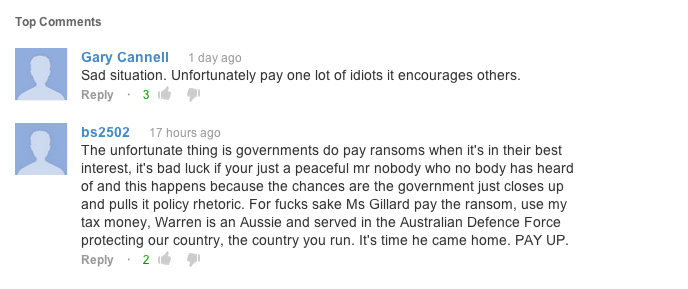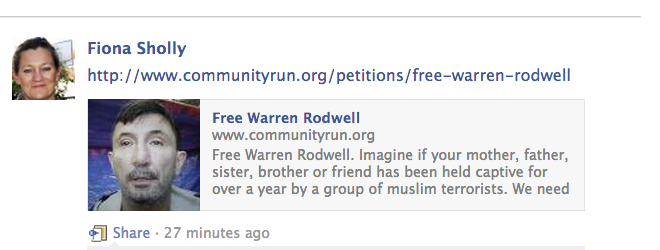SUMMARY
This is AI generated summarization, which may have errors. For context, always refer to the full article.

(UPDATED) MANILA, Philippines – Shortly before midnight of December 26, a YouTube account identifying itself as the “official channel of the Al-Harakatul Islamia” – the formal name of the Abu Sayyaf – uploaded a proof-of-life video of Australian Warren Rodwell, kidnapped more than a year ago from his home Zamboanga City.
A few hours later, a Facebook account shared the video with this message: “Attention!!!! … Warren Rodwell Australian kidnapped victim.” Then it gives a mobile number saying, “He is in need of help.”
Authorities are now investigating the mobile number, which also appears on the YouTube account. Intelligence sources told Rappler they are certain the YouTube account belongs to the Abu Sayyaf because of past activity – it was created May 11, 2010 with video seen more than 25,000 times – and because of the accounts it connects and the network it has created.
The Facebook account which shared the video uses the same symbolism as the YouTube account and goes further, incorporating the black flag, which taps into a motivation of al-Qaeda and its affiliated groups. Authorities discovered the black flag in the Philippines after they raided two terrorist training camps in Mindanao this year.
Al-Qaeda believes its black banners herald the apocalypse that would bring about the triumph of Islam. Its symbolism is linked to a “narrative that convinces them that they’re part of a divine plan,” according to former Federal Bureau of Investigation agent Ali Soufan in his book “The Black Banners: The Inside Story of 9/11 and the War Against al-Qaeda.”
The owner of the mobile number is prepared to bargain, according to a source in touch with him. He said the asking price is US$2 million, but if half of that is delivered, the kidnappers are willing to hand Rodwell over to anyone, including a middleman who is then free to demand the full amount.
This is the way things work with the Abu Sayyaf. In some past kidnappings, smaller groups have handed over their victims to larger groups, who then charge higher amounts for ransom.
This is the first time the kidnappers have turned to social media for ransom – seemingly looking for anyone who will pay a price.
Government and social media reactions
Frustrated Australians react on social media. Aurpar25 picks up the idea, saying “if we all put in 1 dollar …” Gary Cannell disagrees, “Unfortunately, pay one lot of idiots it encourages others.”


Negotiations for Rodwell’s release have been going on since January, but transcripts of conversations seen by Rappler show a confusing process, particularly when it comes to paying ransom. The Australian goverment said earlier this year it would not pay ransom. The Philippines took the same position, but the reality is negotiations are based on an exchange of payment. Sources familiar with the negotiations say they lack a clear leader, and there seem to be differing tactics among Australian agencies like the Australian Federal Police and the Australian Secret Intelligence Service.
“I’d point out that the Philippine government is leading the response to Mr. Rodwell’s kidnapping, assisted by Australian Government agencies as appropriate,” Andrew Byrne, Deputy Head of Mission at the Australian Embassy in Manila, tells Rappler. “The Australian agencies are working to the same objective and their efforts are tightly coordinated. Any suggestion that they are taking different or separate approaches simply has no basis in fact.”
Shortly after this latest video was shared on social media, a group of Australians who started a Facebook page for Rodwell soon after he was kidnapped began an online petition on a site called communityrun, a project of GetUp Australia. The petition, which has been shared on Facebook and other social media sites, is addressed to the Australian Government and says “Warren Rodwell has been held captive by the Abu Sayyaf Group, a Muslim terrorist group for over one year. Enough is enough. Get him out now.” As of Friday morning, Dec. 28 Manila time less than a day after it was started, there were 65 of 100 targeted signatures.

Australia’s Foreign Minister Bob Carr said “confirmation of Mr. Rodwell’s welfare is welcome,” but “his prolonged captivity is a major concern.” He said the Philippine government “is devoting significant resources to securing Mr. Rodwell’s release.”
A Philippine intelligence document obtained by Rappler showed that as of Aug 15, 2012, Rodwell was being held by the Abu Sayyaf in Al-Barka, Basilan, the site of the controversial killing of special forces soldiers in November, 2010.
Other hostages
Other foreign hostages, including a Dutch and Swiss birdwatchers, a Jordanian journalist, his Filipino cameraman and a Japanese, are held by the Abu Sayyaf on the island of Jolo.
Kidnap-for-ransom is a cottage industry for the Abu Sayyaf, a group once funded and supported by al-Qaeda in the early 90’s.
Since then, it has gone through 4 waves vacillating between ideology and crime: from 1991-1998, it was driven by ideological goals, funded and trained by al-Qaeda (including the architect of 9/11, Khalid Shaikh Mohammed). The second wave spanned from 1998 to 2002, when the group turned to crime after the death of its founder – using kidnapping-for-ransom and extortion to raise money. The third wave was from 2002-2008 – when Jemaah Islamiyah leaders, who fled Indonesia after the Bali bombings, helped reorient the group again towards terrorism. Finally, from 2008 to the present, the group degenerated back into kidnapping-for-ransom.
Rodwell, in his video recorded December 16, seems angry but resigned.
“I do not expect to be released before the year 2013 at the earliest,” he says. “I personally hold no hope at all for being released. I do not trust Abu Sayyaf. I do not trust the Australian government. I just don’t trust anyone.” – Rappler.com
Maria A. Ressa is the author of Seeds of Terror and 10 Days, 10 Years: From Bin Laden to Facebook. She led negotiations against the Abu Sayyaf in the 2008 kidnapping of Ces Drilon, Jimmy Encarnacion and Angelo Valderrama.
Add a comment
How does this make you feel?
There are no comments yet. Add your comment to start the conversation.